Tree and Shrub List for Armenia
Partial List of Trees and Shrubs for Armenia
After the massive tree-cutting period of the early 1990s, caused by the economic blockade and the energy crisis, there was much discussion about deforestation in Armenia. During that period people were cutting trees everywhere and removing anything wooden to burn for heat!
Tree planting is the best action to take in order to mitigate deforestation and tree removal. However care must be taken not to unwittingly harm the environment. One may ask how is it possible to harm the environment by planting trees?
There are many non-Armenian tree species (non-native species), which are invasive and can aggressively occupy an area by crowding out and eventually replacing native, indigenous species of trees. Unfortunately, in Armenia, after the massive tree-cutting period of the early 1990s the planting of invasive species became a common practice, mostly due to lack of awareness of the ecological detriment that planting of invasive species can cause.
Below is a partial list of trees and shrubs which are growing in Armenia. We generally recommend planting only species that are labeled as ‘native’. Any species labeled ‘invasive’ should never be planted and actually should be removed whenever possible. These invasive species have a particular ability to produce thousands and thousands of seeds that can germinate, grow and eventually shade out native species.
There are other ecological reasons for planting only native species of plants having to do with the interactions of insects and wildlife with the plant species.
Scientific Name | Common Name | Native Habitat | Native? | Notes |
Acer negundo | boxelder | USA, southern Canada | non-native | invasive |
Acer platanoides | Norway maple | Europe | | |
Acer pseudoplatanus | Planetree maple, Sycamore maple | Europe, western Asia (cultivated for centuries) | | |
Acer tataricum | Tatarian maple | southeast Europe, western Asia | | |
Acer trautvetteri | Caucasian maple | Caucasia, northern Turkey | native | |
Aesculus hippocastanum | Horsechestnut | Greece, Albania | non-native | |
Ailanthus altissima | tree of Heaven | China | non-native | extremely invasive |
Albizia julibrissin | mimosa, silk tree | Iran to central China | non-native | |
Amygdalus communis | almond | Middle East | | |
(Prunus dulcis) | | | | |
Armeniaca vulgaris | apricot | Armenia | native | |
(Prunus armeniaca) | | | | |
Betula pendula | | | | |
| | | | | |
Betula litwinowii | | | native | |
Biota orientalis | Oriental arborvitae | Korea, Manchuria, northern China | non-native | |
(Thuja orientalis) | | | | |
Buddleia davidi | butterfly-bush | China, Japan | non-native | |
Buxus sempervirens | boxwood | southern Europe, northern Africa, western Asia | | |
Caragana arborescens | Siberian peashrub | Siberia, Mongolia | | |
Carpinus caucasica | Caucasian hornbeam | Europe, Caucasus | native | |
Catalpa bignonioides | catalpa | southern USA | non-native | |
Cercis siliquastrum | Judas tree | southern Europe, western Asia | non-native | |
Cornus sanguinea | European dogwood | Europe, western Asia | native | |
Cotoneaster horizontalis | rock cotoneaster | western China | non-native | |
Cydonia oblonga | quince | Caucasus | native | |
Elaeagnus angustifolia | Russian-olive | southern Europe, central Asia,
Altai , Himalayas | native | |
Fagus orientalis | oriental beech | northwest Turkey, Caucasus, Iran | native | |
Forsythia suspensa | weeping forsythia | China | non-native | |
Fraxinus excelsior | European ash | Europe, southwestern Asia | native | |
Fraxinus pennsylvanica | green ash | USA, Canada | non-native | |
Gleditsia triachanthos | honeylocust | USA | non-native | |
Hippophae rhamnoides | seabuckthorn | Europe to China | native | |
Hibiscus syriacus | rose-of-sharon | India, China | non-native | |
Jasminum fruticans | wild jasmine | Mediterranean, Asia Minor | native | |
Junglans regia | English walnut | southeastern Europe to China | native | |
Juniperus virginiana | eastern redcedar | east and central North America | non-native | |
Koelreuteria paniculata | goldenrain tree | China, Korea, Japan | non-native | |
Ligustrum vulgare | European privet | Europe, northern Africa, southwestern Asia | native | |
Lonicera maackii | Amur honeysuckle | Manchuria, Korea | non-native | invasive |
Maclura pomifera | osage orange | USA | non-native | |
Malus domestica | apple | western Asia | naturalized | naturalized nearly everywhere in the world |
| | | | | |
Malus orientalis | | | native | |
Melia azedarach | Chinaberry | India to China | non-native | |
Morus alba | white mulberry | China | naturalized | |
Paulownia tomentosa | empress tree | China | non-native | |
Picea orientalis | Oriental spruce | Caucasus, Asia Minor | | |
Pinus brutia | Turkish pine | west of Caspian Sea to Greece | | |
Pinus eldarica | Afghan pine | ?Caucasus, Russia, Afghanistan, Pakistan | | |
| | | | | |
(Pinus brutia) | | | | |
Pinus halepensis | Aleppo pine, Jerusalem pine | Europe | non-native | |
Pinus nigra | European black pine, Austrian pine | Europe, Balkans, Crimea | non-native | |
P. n. subsp.pallasiana | European black pine | Europe to Turkey | non-native | |
Pinus pinea | stone pine | Europe, Mediterranean | non-native | |
Pinus ponderosa | ponderosa pine | western North America | non-native | |
Pistacia mutica | pistachio | Caucasus | native | |
(P.atlantica var. mutica) | | | | |
Pistacia vera | common pistachio | western Asia | non-native | |
Platanus orientalis | Oriental planetree | southeastern Europe, western Asia | native | |
Populus alba | white poplar | southern Europe to central Asia | native | |
Prunus armeniaca | apricot | Asia | considered native | |
Prunus avium | sweet cherry | Europe, western Asia | native | |
Prunus cerasifera | cherry plum, myrobalan plum | Europe, Caucasus, western Asia | non-native | |
(Prunus mirobalan) | | | | |
Prunus cerasus | sour cherry | Europe, southwest Asia | non-native | |
Prunus domestica | common plum | Europe, southwest Asia | non-native | |
Prunus mahaleb | rock cherry | central Europe to central Asia | native | |
Prunus persica | peach | China | non-native | |
Prunus tomentosa | Nanking Cherry | China to Japan | non-native | |
Punica granatum | pomegranate | Caucasus | native | |
Pyrus communis | European pear | Europe, western Asia | non-native | |
Pyrus caucasica | Caucasian pear | Europe, western Asia | native | |
( P. communis subsp. caucasica) | | | | |
Pyrus demetrii | pear | Caucasus | native (globally threatened endemic species) | |
Pyrus salicifolia | willowleaf pear | southeastern Europe, western Asia | native | |
Quercus castaneifolia | chestnut-leaved oak | Caucasus, Iran | | |
Quercus macranthera | Caucasian oak | Caucasus, western Asia | | |
Quercus pontica | Armenian oak | Caucasus, northeastern Turkey | | |
Quercus robur | english oak | Europe, Caucasus, Asia minor | non-native | |
Ribes aureum | buffalo currant | North America | non-native | |
Ribes nigrum | black currant | northern Europe, northern Asia | non-native | |
Robinia pseudoacacia | black locust | USA | non-native | |
| | | | | |
Rosa sp. | | | native | |
Salix babylonica | Babylon weeping willow | Asia | non-native | |
Sambucus nigra | elderberry | Europe, northwest Africa, southwest Asia, western North America | native | |
Sophora Japonica | pagoda tree | China, Korea | non-native | |
Sorbus aucuparia | mountain ash | Europe, western Asia | native | |
Spiraea x vanhouttei | | | non-native | |
Symphoricarpos albus | Snowberry | USA, Canada | non-native | |
Tamarix araratica | Salt-cedar | | native | |
Taxus baccata | English yew | Europe, northern Africa, western Asia | native | |
Thuja occidentalis | American arborvitae | eastern USA, eastern Canada | non-native | |
Ulmus laevis | European white elm | Europe to Asia | native | |
Weigelia florida | old fashioned weigela | Japan | non-native | |
Ziziphus jujube | Chinese date | southeastern Europe to Asia | native | |
Invasive Species in Armenia
Invasive species in native and non-native ranges
2007-2008
Armenia, ECRC/AUA
USA, University of Montana, University of California
Argentina, Universidad Nacional de La Pamba
Turkey, Adnan Menderes University
Georgia, Institute of Botany
Romania, Institute Of Biological Research
Hungary, Insttute of Ecology and Botany
Studying germination in the native and non-native range of a species can provide unique insights into processes of range expansion and adaptation; however, traits related to germination have rarely been compared between native and nonnative populations. In a series of common garden experiments, we explored whether differences in the seasonality of precipitation, specifically, summer drought vs summer rain, and the amount and variation of annual and seasonal precipitation affect the germination responses of populations of an annual ruderal plant, Centaurea solstitialis, from its native range and from two non-native regions with different climates. We found that seeds from all native populations, irrespective of the precipitation seasonality of the region in which they occurred, and non-native populations from regions with dry summers displayed similarly high germination proportions and rates. In contrast, genotypes from the non-native region with predominantly summer rain exhibited much lower germination fractions and rates and ecology. Organisms transported by humans to regions where they are not native (exotics) commonly face novel selective forces, which given enough genetic variation, may trigger novel evolutionary responses. The worldwide distribution of this species encompasses environments with contrasting precipitation regimes within both native and non-native ranges. Specifically, some of the regions where C. solstitialis grows are characterized by a Mediterranean-type climate with wet winters and dry summers, whereas other regions have a precipitation regime in which most of the precipitation falls during the summer, and winters are substantially drier. In all regions, the species germinates primarily in autumn (Sheley and Larson 1994, Hierro et al. 2006, L. Khetsuriani, L. Janoian and K. Andonian unpubl.); thus, winter conditions may affect its survival. Here, by conducting a series of common garden experiments in a growth chamber, we investigated whether contrasting differences in the seasonality of precipitation and changes in surrogates for environmental quality (e.g. precipitation totals) and risk (e.g. inter-annual variation in precipitation) affect germination responses of C. solstitialis populations occurring across its native range and in two climatically distinct non-native regions.
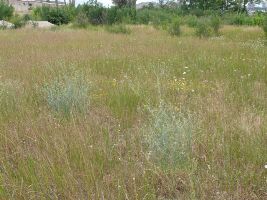
General view of the experimental field in Armenia
To investigate the potential effects of seasonality of precipitation on C. solstitialis germination, we conducted three successive seed collections from populations occurring in regions exepte France, Crete and Armenia, where seeds were pooled within populations. Mean cumulative germination percentages (91 SE) of pappus and non-pappus seeds of C. solstitialis populations plotted against the coefficient of variation of winter precipitation and the probability of occurring a good winter.
Pappus seeds maintained a strong association with variation in winter precipitation (r__0.91, pB0.001), but this relationship did not hold for nonpappus seeds (r__0.36, p_0.172). In addition, germination of both pappus and non-pappus seeds were no longer correlated with the probability of good winters (r_0.44, p_0.117 and r_0.11, p_0.387, respectively). Without Argentina, the association between germination proportions of pappus seeds and variation in annual precipitation improved slightly (r__0.70, p_0.017), whereas the correlation of these proportions with the probability of good years remained non-significant (r_0.39, p_0.150). Finally, as before, germination fractions of non-pappus seeds were not correlated with any of the measures of annual risk, and germination percentages of both seed morphs were not associated with any of the measures describing environmental quality (p_0.250 in all cases).
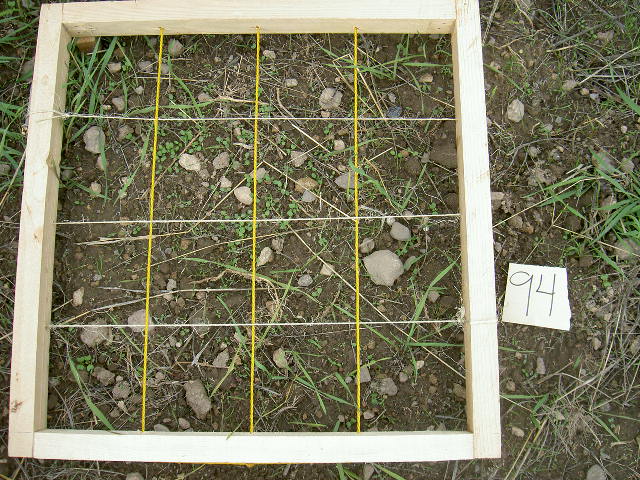 Clines in these studies corresponded to variation in general climatic patterns, such as changes in climate between northern and southern latitudes (Maron et al. 2004, 2007) or between coastal versus inland environments . In contrast to these results, our comparisons based on general climatic patterns (i.e. summer drought vs summer rain) did not detect parallel clines in germination traits for populations from native and non-native ranges, as all native populations, irrespective of the climate in which they occurred, and non-native populations from the region with a summer-drought climate displayed similarly high germination proportions and rates; whereas non-native genotypes from the region with a summer rain regime exhibited much lower germination fractions and rates. On the other hand, our comparisons based on precipitation variables, which are commonly used as surrogates for environmental quality and risk, showed that for the most abundant seed morph, seeds with a pappus, germination responses of populations in both native and non-native ranges correlated strongly with ‘risk’ experienced during the winter. Specifically, and as predicted by bethedging theory, germination fractions of pappus seeds were lower in native and non-native populations experiencing greater inter-annual variation in winter precipitation (Fig. 4). For non-pappus seeds, however, this correlation was greatly influenced by non-native genotypes from central Argentina, which are from the region with the highest variation in winter precipitation of all the studied regions and exhibited the lowest proportions of germinating seeds in all our experiments (Fig. 2_4); after removing central Argentina from analyses, there was no association between germination fractions of non-pappus seeds and winter precipitation variation. Similarly, germination fractions of both pappus and non-pappus seeds correlated with probability of occurrence of good winters only in the presence of Argentinean variables. Overall, these findings suggest that rather than general climatic patterns, the degree of risk experienced at early developmental stages could exert an important control over the germination strategy of C. solstitialis populations in both native and non-native ranges. In addition, they reveal the largely unique nature among studied populations of seed germination in nonnative genotypes from central Argentina. Germination fractions of pappus seeds were also correlated with variation in annual precipitation, suggesting that overall annual risk could also play a role in the germination behavior of C. solstitialis populations. Indeed, populations experiencing comparable variation in winter precipitation in the native and non-native range tended to display similar germination fractions for this seed type . In contrast, for non-pappus seeds the link between degree of dormancy and level of winter risk does not hold when outlier Argentinean variables are removed from analyses, providing weaker support for bet-hedging across C. solstitialis populations.
Clines in these studies corresponded to variation in general climatic patterns, such as changes in climate between northern and southern latitudes (Maron et al. 2004, 2007) or between coastal versus inland environments . In contrast to these results, our comparisons based on general climatic patterns (i.e. summer drought vs summer rain) did not detect parallel clines in germination traits for populations from native and non-native ranges, as all native populations, irrespective of the climate in which they occurred, and non-native populations from the region with a summer-drought climate displayed similarly high germination proportions and rates; whereas non-native genotypes from the region with a summer rain regime exhibited much lower germination fractions and rates. On the other hand, our comparisons based on precipitation variables, which are commonly used as surrogates for environmental quality and risk, showed that for the most abundant seed morph, seeds with a pappus, germination responses of populations in both native and non-native ranges correlated strongly with ‘risk’ experienced during the winter. Specifically, and as predicted by bethedging theory, germination fractions of pappus seeds were lower in native and non-native populations experiencing greater inter-annual variation in winter precipitation (Fig. 4). For non-pappus seeds, however, this correlation was greatly influenced by non-native genotypes from central Argentina, which are from the region with the highest variation in winter precipitation of all the studied regions and exhibited the lowest proportions of germinating seeds in all our experiments (Fig. 2_4); after removing central Argentina from analyses, there was no association between germination fractions of non-pappus seeds and winter precipitation variation. Similarly, germination fractions of both pappus and non-pappus seeds correlated with probability of occurrence of good winters only in the presence of Argentinean variables. Overall, these findings suggest that rather than general climatic patterns, the degree of risk experienced at early developmental stages could exert an important control over the germination strategy of C. solstitialis populations in both native and non-native ranges. In addition, they reveal the largely unique nature among studied populations of seed germination in nonnative genotypes from central Argentina. Germination fractions of pappus seeds were also correlated with variation in annual precipitation, suggesting that overall annual risk could also play a role in the germination behavior of C. solstitialis populations. Indeed, populations experiencing comparable variation in winter precipitation in the native and non-native range tended to display similar germination fractions for this seed type . In contrast, for non-pappus seeds the link between degree of dormancy and level of winter risk does not hold when outlier Argentinean variables are removed from analyses, providing weaker support for bet-hedging across C. solstitialis populations.
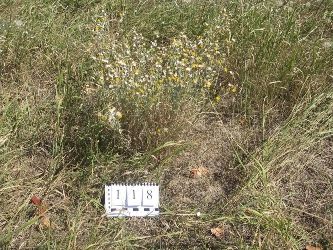 Several mechanisms could be responsible for the genetic differentiation in germination traits of Californian versus Argentinean populations, including coincidental introductions, genetic drift, and natural selection operating on phenotypes formed by either a novel combination of genes or pre-adapted genotypes (i.e. the sorting-out hypothesis _ Mu¨ller-Scha¨rer and Steinger 2004; see Leger and ice 2007 for a comprehensive discussion on these mechanisms). Outcrossing plants partition most of their genetic diversity within, rather than among, populations, which increases the probability of possessing high genetic variation upon introduction because even a few immigrants can carry much of the species’ genetic variation.
Several mechanisms could be responsible for the genetic differentiation in germination traits of Californian versus Argentinean populations, including coincidental introductions, genetic drift, and natural selection operating on phenotypes formed by either a novel combination of genes or pre-adapted genotypes (i.e. the sorting-out hypothesis _ Mu¨ller-Scha¨rer and Steinger 2004; see Leger and ice 2007 for a comprehensive discussion on these mechanisms). Outcrossing plants partition most of their genetic diversity within, rather than among, populations, which increases the probability of possessing high genetic variation upon introduction because even a few immigrants can carry much of the species’ genetic variation.
Full article available in Oikos 118: 529_538, 2009
doi: 10.1111/j.1600-0706.2009.17283.x,
# 2009 The Authors. Journal compilation # 2009 Oikos
Subject Editor: Pia Mutikainen. Accepted 31 October 2008
“Germination responses of an invasive species in native and non-native ranges”
Jose´ L. Hierro, O¨zkan Eren, Liana Khetsuriani, Alecu Diaconu, Katalin To¨ro¨ k, Daniel Montesinos,
Krikor Andonian, David Kikodze, Levan Janoian, Diego Villarreal, Marı´a E. Estanga-Mollica and Ragan M. Callaway
Endemic Wheats of Armenia Project 2008
 Armenia, although a small country, is very rich in wild relatives of cultivars, including the ancestors and donors of such important cult ivated plants as bread cereals. The study of wild species of wheat, barley, goat grass, rye and others of the cereal crops represents a large practical interest. Progenitors of cultivars are often carriers of valuable attributes and features, such as, high drought and frost resistance, the ability to grow on relatively poor soils, and resistance to pests and disease. That is why wild relatives are valuable material for the selection of new varieties of cultivated plants.
Armenia, although a small country, is very rich in wild relatives of cultivars, including the ancestors and donors of such important cult ivated plants as bread cereals. The study of wild species of wheat, barley, goat grass, rye and others of the cereal crops represents a large practical interest. Progenitors of cultivars are often carriers of valuable attributes and features, such as, high drought and frost resistance, the ability to grow on relatively poor soils, and resistance to pests and disease. That is why wild relatives are valuable material for the selection of new varieties of cultivated plants.
In addition to this, purely in practical terms, the study of wild relatives of cereal crops are of particular help in understanding the path by which many thousands of years ago the creation of the modern cultivated grasses from wild cereal crops took place, and in giving a more precise definition to the regions where the agricultural civilization arose. From that viewpoint the study of the history of domestic bread cereals helps to shed light not only on the history of agriculture but on the history of humans in a broad sense.
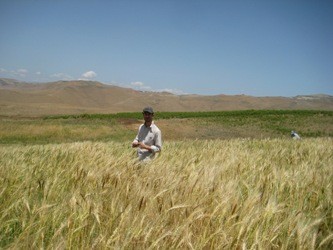 Conserving the rich gene pool of wild relatives of wheat cultivars in Armenia is an urgent concern, as more and more land is disturbed by growing economic activity, land privatization, and other factors. Therefore, it is extremely important to evaluate the different Armenian populations of wheat and other cereals, and to conserve this valuable material. This can be achieved through periodic population monitoring, conservation in situ, and through collection of a seed material for preservation ex situ.
Conserving the rich gene pool of wild relatives of wheat cultivars in Armenia is an urgent concern, as more and more land is disturbed by growing economic activity, land privatization, and other factors. Therefore, it is extremely important to evaluate the different Armenian populations of wheat and other cereals, and to conserve this valuable material. This can be achieved through periodic population monitoring, conservation in situ, and through collection of a seed material for preservation ex situ.
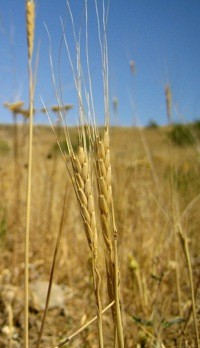
Previously, botanists have conducted numerous comprehensive studies of cereal crops, and also led archeobotanical excavations which shed light on the relatively early stages of the domestication of grasses. This current project will facilitate more comprehensive studies of the populations of wild cereal crops through the use of modern cytogenetic and molecular biology methods.





 Conserving the rich gene pool of wild relatives of wheat cultivars in Armenia is an urgent concern, as more and more land is disturbed by growing economic activity, land privatization, and other factors. Therefore, it is extremely important to evaluate the different Armenian populations of wheat and other cereals, and to conserve this valuable material. This can be achieved through periodic population monitoring, conservation in situ, and through collection of a seed material for preservation ex situ.
Conserving the rich gene pool of wild relatives of wheat cultivars in Armenia is an urgent concern, as more and more land is disturbed by growing economic activity, land privatization, and other factors. Therefore, it is extremely important to evaluate the different Armenian populations of wheat and other cereals, and to conserve this valuable material. This can be achieved through periodic population monitoring, conservation in situ, and through collection of a seed material for preservation ex situ.